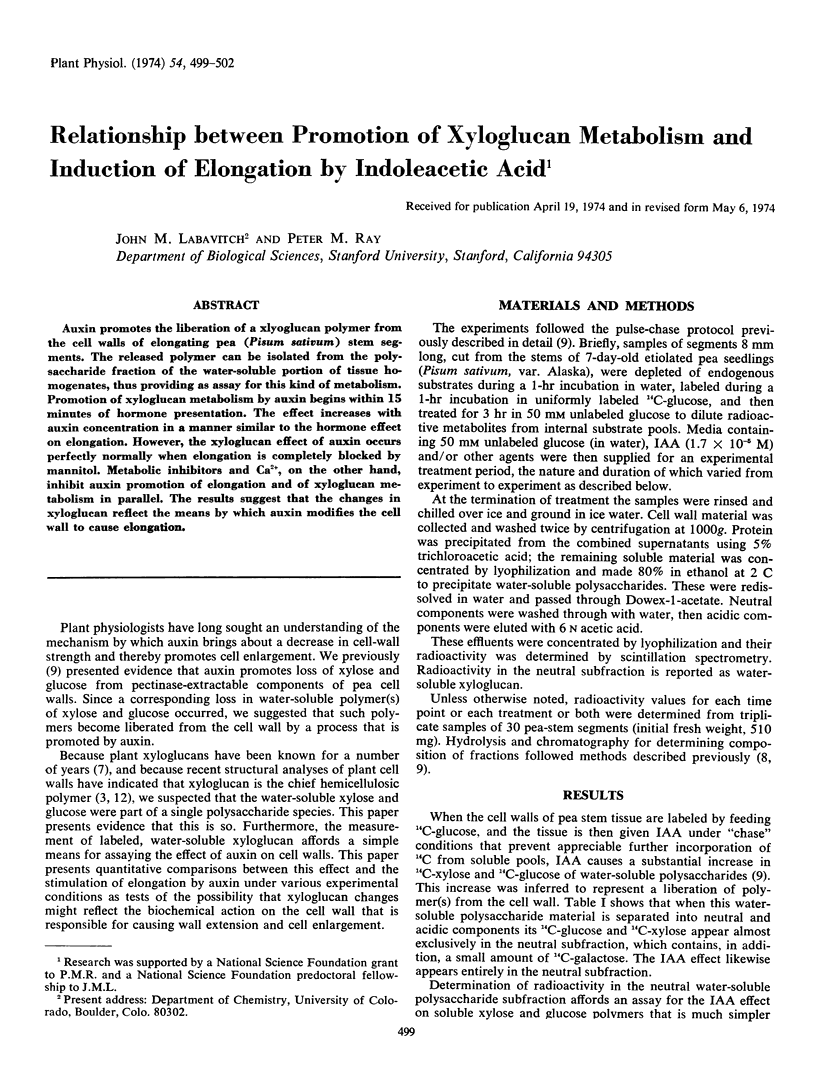Relationship between Promotion of Xyloglucan Metabolism and Induction of Elongation by Indoleacetic Acid (original) (raw)
Abstract
Auxin promotes the liberation of a xlyoglucan polymer from the cell walls of elongating pea (Pisum sativum) stem segments. The released polymer can be isolated from the polysaccharide fraction of the water-soluble portion of tissue homogenates, thus providing as assay for this kind of metabolism. Promotion of xyloglucan metabolism by auxin begins within 15 minutes of hormone presentation. The effect increases with auxin concentration in a manner similar to the hormone effect on elongation. However, the xyloglucan effect of auxin occurs perfectly normally when elongation is completely blocked by mannitol. Metabolic inhibitors and Ca2+, on the other hand, inhibit auxin promotion of elongation and of xyloglucan metabolism in parallel. The results suggest that the changes in xyloglucan reflect the means by which auxin modifies the cell wall to cause elongation.

Selected References
These references are in PubMed. This may not be the complete list of references from this article.
- Abdul-Baki A. A., Ray P. M. Regulation by auxin of carbohydrate metabolism involved in cell wall synthesis by pea stem tissue. Plant Physiol. 1971 Apr;47(4):537–544. doi: 10.1104/pp.47.4.537. [DOI] [PMC free article] [PubMed] [Google Scholar]
- Barkley G. M., Evans M. L. Timing of the auxin response in etiolated pea stem sections. Plant Physiol. 1970 Feb;45(2):143–147. doi: 10.1104/pp.45.2.143. [DOI] [PMC free article] [PubMed] [Google Scholar]
- Bauer W. D., Talmadge K. W., Keegstra K., Albersheim P. The Structure of Plant Cell Walls: II. The Hemicellulose of the Walls of Suspension-cultured Sycamore Cells. Plant Physiol. 1973 Jan;51(1):174–187. doi: 10.1104/pp.51.1.174. [DOI] [PMC free article] [PubMed] [Google Scholar]
- CHRISTIANSEN G. S., THIMANN K. V. The metabolism of stem tissue during growth and its inhibition. I. Carbohydrates. Arch Biochem. 1950 Apr;26(2):230–247. [PubMed] [Google Scholar]
- Christiansen G. S., Kunz L. J., Bonner W. D., Thimann K. V. THE ACTION OF GROWTH INHIBITORS ON CARBOHYDRATE METABOLISM IN THE PEA. Plant Physiol. 1949 Jan;24(1):178–181. doi: 10.1104/pp.24.1.178. [DOI] [PMC free article] [PubMed] [Google Scholar]
- Keegstra K., Talmadge K. W., Bauer W. D., Albersheim P. The Structure of Plant Cell Walls: III. A Model of the Walls of Suspension-cultured Sycamore Cells Based on the Interconnections of the Macromolecular Components. Plant Physiol. 1973 Jan;51(1):188–197. doi: 10.1104/pp.51.1.188. [DOI] [PMC free article] [PubMed] [Google Scholar]
- Labavitch J. M., Ray P. M. Turnover of cell wall polysaccharides in elongating pea stem segments. Plant Physiol. 1974 May;53(5):669–673. doi: 10.1104/pp.53.5.669. [DOI] [PMC free article] [PubMed] [Google Scholar]
- Loescher W. H., Nevins D. J. Turgor-dependent Changes in Avena Coleoptile Cell Wall Composition. Plant Physiol. 1973 Sep;52(3):248–251. doi: 10.1104/pp.52.3.248. [DOI] [PMC free article] [PubMed] [Google Scholar]
- Tagawa T., Bonner J. Mechanical Properties of the Avena Coleoptile As Related to Auxin and to Ionic Interactions. Plant Physiol. 1957 May;32(3):207–212. doi: 10.1104/pp.32.3.207. [DOI] [PMC free article] [PubMed] [Google Scholar]
- Wilder B. M., Albersheim P. The Structure of Plant Cell Walls: IV. A Structural Comparison of the Wall Hemicellulose of Cell Suspension Cultures of Sycamore (Acer PseudoPlatAnus) and of Red Kidney Bean (Phaseolus Vulgaris). Plant Physiol. 1973 May;51(5):889–893. doi: 10.1104/pp.51.5.889. [DOI] [PMC free article] [PubMed] [Google Scholar]